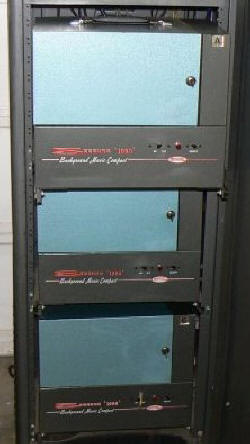Background Music Systems
Featured below are several of Seeburg's Background Music Systems. These were used to provide 'Mood Music' in the days before Muzak was generally available. The SICM could play any type of 78 RPM record, while the others used specially produced, 16 2/3 RPM records provided by Seeburg. The record sets were leased by Seeburg to the owner of the machine, could only be placed into service on the date specified on the carton, and had to be returned after a specific period of time. Seeburg offered several different sets of music, tailored towards holidays, type of music, etc. The recordings were generally instrumental covers of recently popular tunes, by unnamed groups.
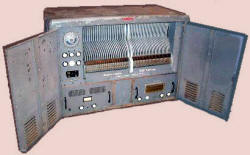 |
SICM Seeburg Industrial Commercial Music
200 Selections, 78 RPM
Introduced sometime around 1948 Housed in a battleship gray metal cabinet, rumored to weigh as much as a battleship. This machine introduced the mechanism used in the M100A jukebox, the first 100 selection coin-operated machine. It was actually used to field test the new mechanism, to get the bugs out before going into jukebox production with it. Two base castings, record magazines, and lever selectors were bolted together, giving 200 selections. It played 10 or 12 inch 78s, but the same gear set used to convert an M100A to play 12-inch 33 1/3 RPM LPs will work here, too. Photo provided by 'Seeburg Ed', who has a website devoted to the Seeburg Library units. |
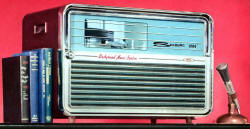 |
BMS1/BMS2.
Background Music Systems, 25 records, 16⅔
RPM Price (October, 1963): $695. Uses custom 9-inch records with 2 inch center holes turning at 16 2/3 RPM. These units were replaced, for the most part, by 'Muzak', but played the same sort of elevator music (instrumental covers of contemporary songs, but recorded by groups you never heard of). At left is the model number BMS2, sometimes called the 'microwave', due to its resemblance to one. |
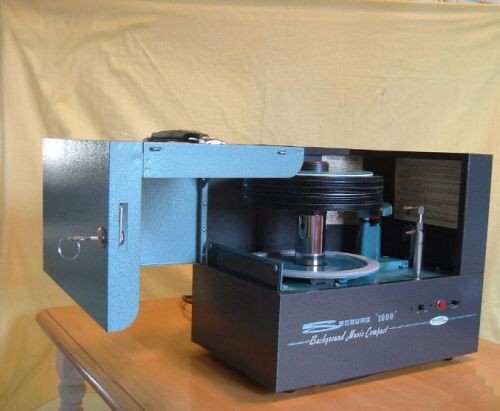 |
BMC1 Background Music Compact,
25 records, 16⅔ RPM Price (October, 1963): $495 Less flashy version of the BMS2 using the same mechanism, housed in a utilitarian cabinet, instead of the microwave look-alike above. It's hard to make out, but there is a stack of records at the top of the unit. The post at the right holds the record cleaning brushes. The lower turntable supports the records and also serves to lift them back up to the top when all have been played. This machine could hold something like 37 hours of yawn-inducing music, guaranteed to cure your insomnia! |
|
|
SABMC2 Background Automatic Music Center.
As you can see, this consisted of three BMC1s stacked in a 19-inch equipment cabinet. It also included a timer assembly. I believe this system was intended to give a much greater variety of background music choices than a single unit. Another possibility is that the system could be set up to play different types of music for different environments in the same building. For example, the offices would get one type of music, while the factory floor would get another. Below is a description of the background music business, kindly provided by Kevin Green:
|
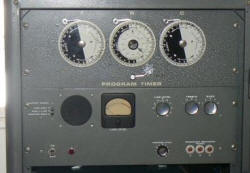 |
The control panel of the SABMC2. The three timers makes it possible to program different music for different times of day. |
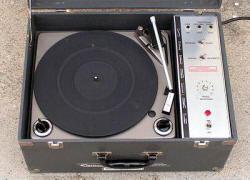 |
MPE1 Electronic
Memory Programmer This unit was offered on a recent Internet auction. The MPE1 was used to occasionally inject a commercial into the background music. The audio output of the Background Music system plugs into this unit, which then outputs either the background music audio, or the commercial, which comes from a record on the MPE1 turntable. The records were to be specially cut with the commercial on them, but obviously you could put any record you wanted on the turntable. The turntable was purchased from Voice of Music. Control switches gave you the choice of only playing background music, only playing what was on the turntable, or a mixture of both. The rotary selector switch without the knob in the photo lets you choose between 1 and 10 background music cuts per MPE1 record cut. It worked by sensing the quiet passages between selections to activate a stepper switch which would interject MPE1 audio once the wiper arm reached the position selected by the rotary switch. Photo from ebay. Many thanks to Warren Rowe of C/W Rowe Jukebox Sales and Service for sending me the Installation manual for this esoteric piece of Seeburgia! |
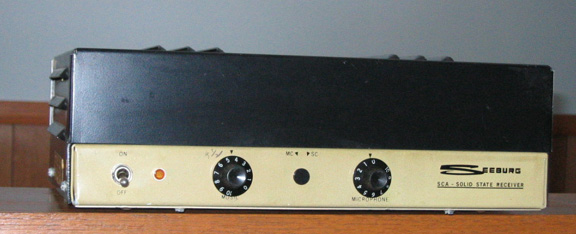 |
Every FM station in the U.S. has a bandwidth of 100 KHz, of which only 53 KHz is used for normal stereo FM (consisting of monaural audio, 19 KHz stereo pilot tone, and the Left/Right stereo programmed around a 38 KHz subcarrier). Many FM Radio stations carry auxiliary programs in their SCA (Subsidiary Communications Authorization) bandwidth. There are two subcarriers available for each station, one centered at 67.65 and the other at 92 KHz. This is a Seeburg tuner designed to receive background music on these subcarriers, as a competitor to Muzak. Photo courtesy Kevin Green. |
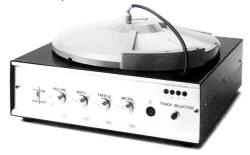 |
The MTN (Music Theater Network) Tape-Top player was a machine about
14" square and 5" high which had a power cord and audio connections on
the back panel, a power switch, track-select button and four LEDs on the
front panel, and a turntable and a DIN plug at the end of a cord up top.
The cartridge enclosed an endless-loop tape, a platter with rollers of some sort, a four-track tape head, and a DIN socket all in a plastic housing reminiscent of Disney's Space Mountain. To operate the machine, you'd place the Tape on the Top of the machine, plug in the DIN plug, and turn it on. Somehow, the constant speed turntable caused the tape inside to run at a constant speed, the audio was picked up by the heads mounted somewhere in there, and the signal was sent through the DIN cable. In theory. In practice, the tapes were extremely unreliable, especially after shipping (which is necessary in the background music business). It's hard to believe that some small environmental music company actually commissioned someone to design a totally new tape transport for their business, but I've never seen such a beast used anywhere else, and I can't imagine anyone else wanting something this awful and troublesome. And expensive – remember that there's a 4-track head in every cartridge, along with rollers and capstans and stuff. Again, the only moving part in the player is the turntable. Photo and text courtesy Kevin Green. |
